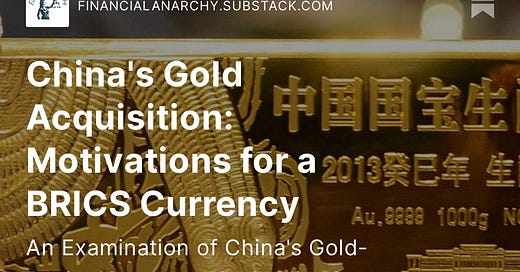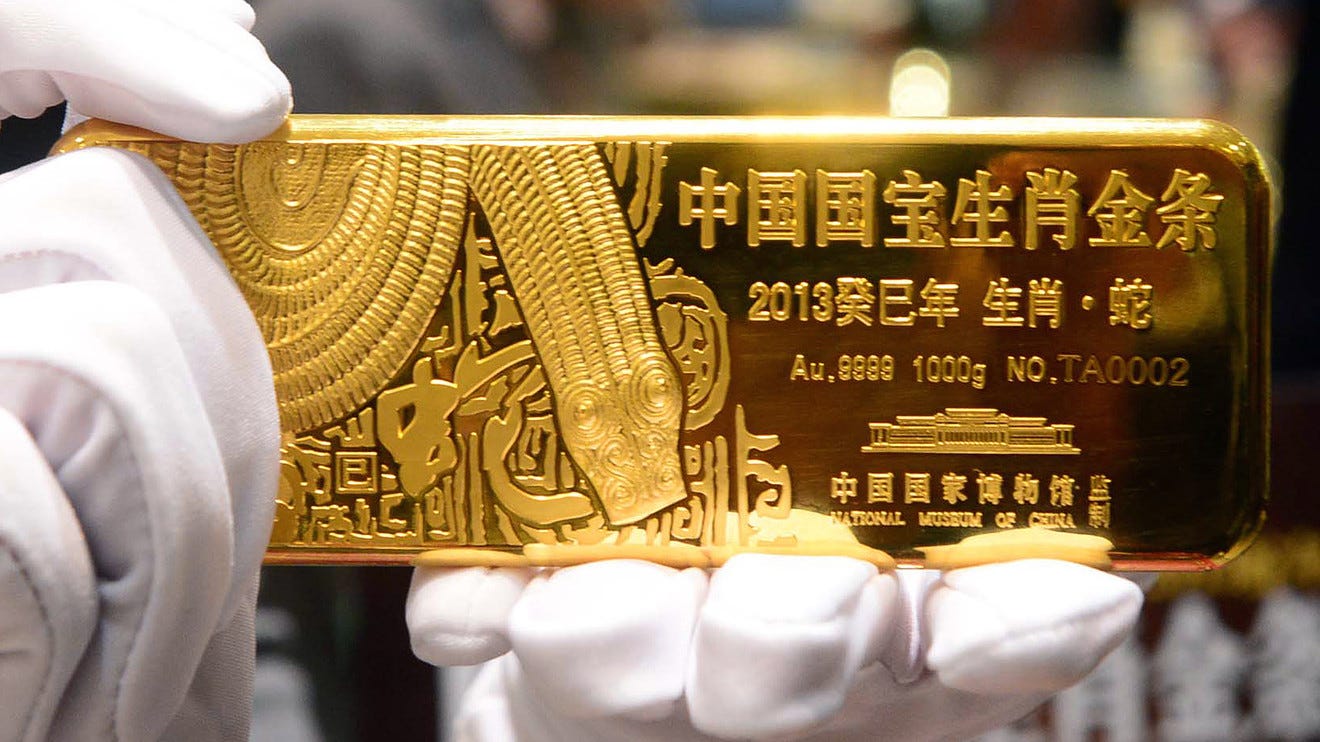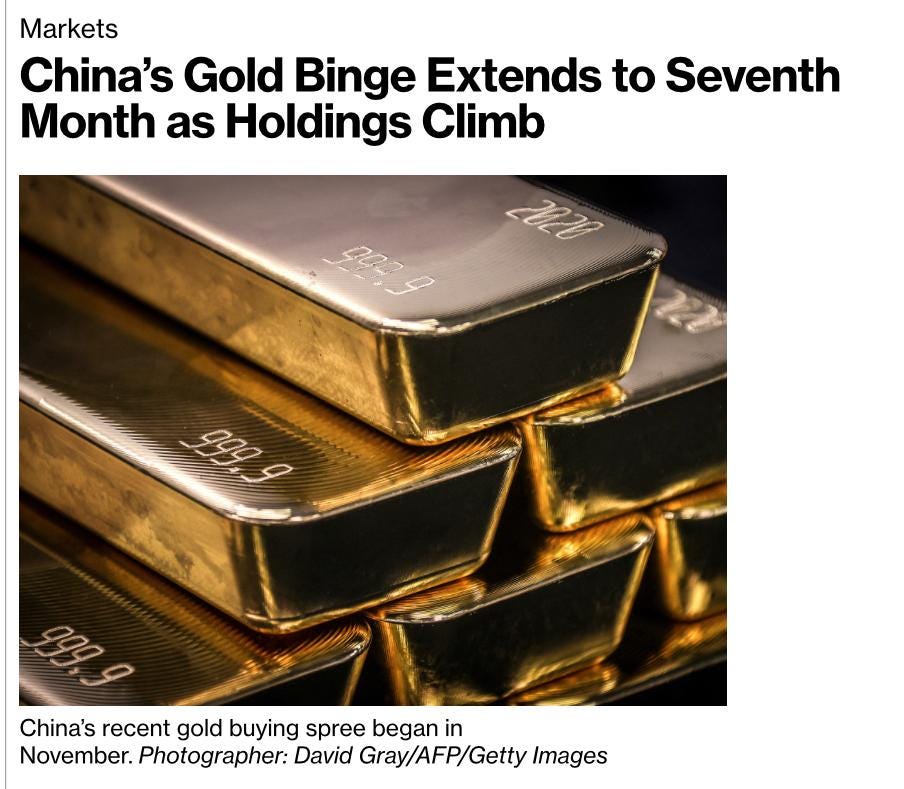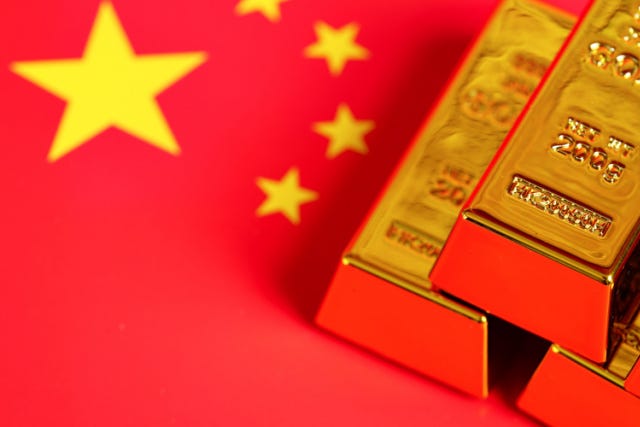China's Gold Acquisition: Motivations for a BRICS Currency
An Examination of China's Gold-Buying Spree and its Implications for the Global Financial Landscape
Introduction
Central banks worldwide have been engaging in a remarkable gold-buying spree, capturing global attention as they seek to diversify their reserves. This surge in gold purchases has coincided with the United States' ongoing efforts, under President Joe Biden, to wield the US dollar as a geopolitical weapon. While several nations have joined this trend, China stands out as a prominent player, amassing historic quantities of the yellow metal. This raises an important question: what are China's intentions behind this gold acquisition frenzy?
In a recent report by the Gold Telegraph, it was revealed that central banks' gold purchases have absorbed nearly a quarter of global gold production in the current year. As central banks worldwide retreat from the dollar, China has emerged as the standout buyer. Just two days ago, the Chinese Central Bank announced its acquisition of an additional 16 tons of gold in May, bringing its total purchases to a staggering 144 tons since November. If these figures are accurate, China's total gold holdings would reach an estimated 2,100 tons, making it one of the world's largest holders of the precious metal.
China's decision to invest heavily in gold begs the question of where the funds originate. Intriguingly, China has also been reducing its holdings of U.S. government treasuries since 2021. The reduction is substantial, with the holdings declining from 1.1 trillion to 850 billion dollars. Such actions prompt further inquiry into China's motivation to distance itself from the U.S. dollar.
Two interpretations have emerged to explain China's retreat from the dollar. The first, a conventional argument, suggests that China is taking precautionary measures, aligning itself with other nations in anticipation of potential U.S. dollar weaponization. President Biden's recent actions against Russia and threats to other countries regarding LGBT policies reinforce this narrative. A seemingly straightforward solution to this concern would be for governments to prioritize the importance of a reserve currency over immediate political gains.
The second interpretation presents a more intriguing possibility—the nuclear story. This theory suggests that China's substantial gold accumulation indicates preparations for a gold-backed currency. Russia has also dabbled in similar ideas. However, it is unlikely that China would employ this strategy with its own currency, the Yuan, as a paper Yuan allows them to underprice their exports and control inflation. Rather, the proposition is for China to introduce a fresh currency, possibly tied to the BRICS anti-dollar alliance, backed by gold.
The Potential of a Gold-Backed BRICS Currency
If China were to pursue a gold-backed currency within the BRICS framework, it could lead to a seismic shift in the global financial landscape. Presently, countries like Mexico and Korea do not use the dollar domestically but leverage their own currencies for internal transactions, utilizing the strong dollar as a trade rail. This arrangement provides the best of both worlds—cheap exports and a robust international trading platform. Should China introduce a gold-backed BRICS currency, it would fundamentally challenge the dominance of the U.S. dollar as a store of value, a primary reason for its worldwide acceptance.
Over the past two decades, the U.S. dollar has depreciated significantly against gold, losing approximately 85 percent of its value. Gold, in contrast, has remained a solid and enduring asset. However, gold's lack of liquidity has been a limiting factor for its widespread use as a currency. A gold-backed BRICS currency would bridge this gap, as it would essentially be a paper currency equivalent to gold. Initially, the market may be skeptical, but as individuals and institutions gain confidence through trading this currency for gold, the acceptance and adoption would gradually spread. The conversion of trade invoices, central bank holdings, private bank holdings, and investment flows would undergo a transformative shift within three to five years, rendering the currency world unrecognizable.
Determining the amount of gold required for China to establish a gold-backed BRICS currency is a crucial consideration. Before the U.S. abandoned the gold standard during the Nixon era, its currency had a mere 2 percent gold backing, equating to two dollars in gold for every hundred dollars in M2. Applying this historical context, China's 2,100 tons of gold could theoretically support a new currency worth around six trillion dollars. Such a valuation would position the gold-backed BRICS currency as the world's fifth-largest, trailing only the Japanese yen.
While the potential advantages of a gold-backed BRICS currency are intriguing, the decision for China to embark on this path is not without risks. A move of this magnitude would challenge the status quo, disrupt existing financial structures, and invoke significant resistance from global economic powers. Consequently, it remains uncertain whether China possesses the determination and resolve to undertake such a bold endeavor. However, should China proceed, it is certain that the consequences for the United States, both economically and geopolitically, would be profound and catch many off guard.
Conclusion
As central banks worldwide join a gold-buying spree, China's acquisitions stand out as historically significant. The motivations behind China's accumulation of gold are multifaceted and subject to interpretation. While some argue that China is preparing for a potential weaponization of the U.S. dollar, others speculate that it is amassing gold as a precursor to introducing a gold-backed currency within the BRICS framework. The latter proposition, if realized, would reshape the global financial landscape and challenge the dominance of the U.S. dollar as a store of value.
A gold-backed BRICS currency would address the liquidity limitations of gold, making it a viable medium of exchange. The journey toward such a currency would not be immediate, but gradual adoption would occur as trust and confidence build through practical trading experiences. In time, the gold-backed BRICS currency could displace the U.S. dollar and usher in a new era of monetary arrangements.
The decision for China to pursue a gold-backed BRICS currency would carry considerable risks and face fierce resistance from established economic powers. It is unclear whether China possesses the resolve to undertake such a substantial transformation. However, if it does, the repercussions for the United States, both economically and geopolitically, would be momentous.
As we witness the central banks' gold-buying spree and monitor China's evolving strategies, the potential shift toward a gold-backed BRICS currency looms as a captivating prospect. The coming years will undoubtedly be crucial in determining the trajectory of global financial systems and the role of the U.S. dollar in the ever-changing landscape of international relations and trade.
Like, Subscribe, and Share to Spread the Word!
Subscribed
If you found this analysis informative and eye-opening, we invite you to like, subscribe, and share this video to help us spread the word. Together, we can build a community of Financial Anarchy advocates who are dedicated to promoting financial literacy and advocating for sound monetary policies. By amplifying our message, we can empower individuals to take control of their financial well-being and contribute to a more equitable and sustainable future.
Support Our Work with a Bitcoin Donation
We also offer the opportunity to support our work and help us continue building the Financial Anarchy community. If you would like to make a contribution, we gratefully accept donations in Bitcoin. Your support will enable us to create more educational content, engage in meaningful activism, and further our mission of challenging the status quo. To donate, please use the following Bitcoin address:
1EkmtWDYzuhkiv3iYozKVnZFxsQxDetnfH
Thank you for joining us on this journey of understanding and change. Together, we can shape a brighter financial future for all.









